Geography
Egypt is known for their pyramids, Sahara Desert and The Nile River (Wahidie, 2022). New Mexico and Texas merging into one state would be similar to what the size of Egypt would look like (Metz, 1990). With about 1,001,449 square kilometers of land in total (Metz, 1990). Egypt does not conform to common geographic features such as rivers and mountains. Remarkable straight lines are the common boundaries in Egypt. The longest straight line is shared with Sudan, consisting of 1,273 kilometers (Coutsoukis, 1990). Land boundaries are also shared with Israel, Libya, Sudan and the Gaza Strip (Coutsoukis, 1990).
Climate
According to Macdonald (2022), Egypt has an arid desert climate which could mean that days can tend to be both hot and sunny. As Hamed, Nashwan & Shahid (2022) mentions, Egypt is environmentally one of the most fragile regions of the world because of it being a hyper-arid country. Macdonald states in her article “Weather in Egypt: Climate, Seasons, and Average Monthly Temperature”, that since Egypt is located in the northern hemisphere, its seasons could resemble those of Europe and North America with the winter being in the months of November through January, and the summer being in the months of June and August. Macdonald (2022) found that June, July, and August are the hottest months within the Egyptian capital, Cairo. Macdonald (2022) also recommends that loose clothing made with natural fibers (cotton or linen), should be highly recommended to visitors who chose to travel to Cairo around that time. The weather in Spring usually consists of days being typically warm, but strong winds come along with the season which creates sandstorms (Macdonald, 2022) which can be dangerous. Hamed, Nashwan & Shahid (2022) also state another concerning factor in Egypt’s weather which is that it has become a hot spot for climatic extremes and aridity change in the global warming context. Since there was an unavailability of a detailed and reliable climate zonation map, there was an interference to climate studies in Egypt (Hamed, Nashwan & Shahid (2022). A study would later reveal that Egypt’s identifiable climate zones could be recognized when the land area was classified into nine zones using the image analysis technique Hamed, Nashwan & Shahid (2022).
Natural Resources
According to (Rafie, 2020), Egypt is known for the quality and reputation regarding cotton in the fashion world. Some natural resources consist of petroleum, phosphate and natural gas ( Pike, n.d ). The Nile delta possesses most of the natural gasses, located offshore from the Mediterranean sea (Younes, 2015). The Nile River serves as one of the most essential resources in Egypt. The Nile is not only accessible to gas but also serves as the main source of water (Younes, 2015). The country has more than 65,201 billion cubic feet of natural gas, stated by the Egyptian government (Kiprop, 2019). The most important natural gas field is the Zohr gas Field which is situated within the Mediterranean (Lempriere, 2018). Egypt also deposits large amounts of petroleum.The Petroleum oil reserve in Egypt is considered as the sixth largest on the African continent (Lempriere, 2018).




